개요
재료 과학 및 공학 분야에서 "구상화 분말"은 특히 금속 적층 제조, 분말 야금 및 관련 분야에서 중요한 구성 요소가 되었습니다. 이 유형의 분말은 형태를 변화시키는 고유한 공정을 거쳐 구형 입자를 생성하여 유동성, 충전 밀도 및 다양한 응용 분야에서 전반적인 성능을 향상시킵니다. 그렇다면 구상화 분말이란 정확히 무엇일까요? 첨단 제조에서 왜 그렇게 중요할까요? 이 종합 가이드에서는 구상화 분말의 구성 및 특성에서 다양한 응용 분야와 장점까지 모든 것을 다루면서 구상화 분말의 모든 것을 살펴봅니다. 또한 특정 금속 분말 모델을 자세히 살펴보고 이 기사가 끝날 때쯤에는 이 매혹적인 재료에 대한 깊은 이해를 갖도록 할 것입니다.
구상화 분말 이해
구상화 분말이란 무엇인가요?
구상화 분말은 구형 모양을 얻기 위해 가공된 금속 분말의 한 유형입니다. 구상화 공정은 일반적으로 불규칙한 모양의 입자를 매끄럽고 둥근 입자로 변환하는 열처리 또는 분무 기술을 포함합니다. 이러한 수정은 분말의 유동성을 크게 향상시키고 표면적 대 부피 비율을 줄이며 충전 밀도를 향상시킵니다. 이러한 특성으로 인해 구상화 분말은 적층 제조, 분말 야금 및 코팅 응용 분야와 같은 산업에서 매우 바람직합니다.
구상화가 중요한 이유는 무엇인가요?
금속 분말을 구형으로 만드는 데 왜 어려움을 겪어야 하는지 궁금할 수 있습니다. 그 이유는 이러한 분말이 제공하는 향상된 성능에 있습니다. 구형 분말은 우수한 유동 특성을 가지며, 이는 일관된 재료 흐름이 고품질 부품 제작에 필수적인 3D 프린팅과 같은 공정에 매우 중요합니다. 또한 이러한 분말은 더 조밀하게 충전되어 최종 제품의 기계적 특성을 향상시킬 수 있습니다. 표면적이 감소하면 산화 및 오염이 줄어들어 더 순수한 최종 제품을 얻을 수 있습니다.

구상화 분말의 응용 분야
구상화 분말은 만능 솔루션이 아닙니다. 적용 분야는 금속의 종류, 최종 제품의 원하는 특성 및 제조 공정에 따라 다릅니다. 구상화 분말이 사용되는 주요 분야는 다음과 같습니다.
| 애플리케이션 | 설명 |
|---|---|
| 적층 제조(3D 프린팅) | 일관된 재료 흐름과 층 증착을 통해 매우 상세하고 강력한 구성 요소를 생산하는 데 사용됩니다. |
| 분말 야금 | 압축 및 소결 공정을 통해 조밀하고 강한 금속 부품을 생산하는 데 필수적입니다. |
| 용사 코팅 | 균일한 분포와 기판에 대한 강력한 접착력을 보장하여 코팅의 품질을 향상시킵니다. |
| 금속 사출 성형(MIM) | 원료 유동성과 최종 제품의 밀도 및 기계적 특성을 향상시킵니다. |
| 표면 처리 | 내마모성, 경도 및 내식성을 향상시키기 위해 표면 개질 기술에 사용됩니다. |
구상화 분말의 구성
구상화 분말의 주요 요소
구상화 분말의 구성은 특정 응용 분야의 요구 사항을 충족하도록 맞춤화됩니다. 일반적으로 이러한 분말은 기본 금속, 합금 원소 및 때로는 특정 특성을 향상시키기 위한 소량의 기타 화합물로 구성됩니다. 다양한 구상화 분말에서 발견되는 일반적인 요소는 다음과 같습니다.
| 요소 | 구상화 분말에서의 역할 |
|---|---|
| 철(Fe) | 강도와 경도를 제공하는 강철 및 철 기반 분말에 흔히 사용됩니다. |
| 알루미늄(Al) | 경량 및 내식성이 뛰어나 항공우주 및 자동차 분야에 자주 사용됩니다. |
| 티타늄(Ti) | 높은 강도 대 중량 비율로 항공우주 및 의료와 같은 고성능 응용 분야에 이상적입니다. |
| 니켈(Ni) | 내식성 및 인성을 향상시키며 고온 응용 분야의 초합금에 자주 사용됩니다. |
| 구리(Cu) | 우수한 전기 전도성을 제공하며 전자 제품 및 열 관리에 사용됩니다. |
| 코발트 (Co) | 내마모성 및 경도를 향상시키며 절삭 공구 및 고강도 응용 분야에 일반적으로 사용됩니다. |
| 크롬(Cr) | 스테인리스강 및 내마모성 응용 분야에 사용되는 내식성 및 경도를 추가합니다. |
이러한 각 요소는 다양한 비율로 결합되어 다양한 산업 응용 분야에 적합한 특정 특성을 가진 분말을 만들 수 있습니다.
구상화 분말의 특성
물리 및 화학적 특성
구상화 분말의 특성은 구성 및 구상화 공정의 영향을 받습니다. 주요 특성은 다음과 같습니다.
| 속성 | 설명 |
|---|---|
| 입자 크기 분포 | 일반적으로 15~150미크론 범위이며 유동성 및 충전 밀도에 영향을 미칩니다. |
| 형태학 | 유동성을 향상시키고 마찰을 줄이는 구형 모양과 매끄러운 표면. |
| 흐름성 | AM 공정에서 일관된 재료 공급에 매우 중요한 구형 모양으로 인한 높은 유량. |
| 겉보기 밀도 | 불규칙한 분말에 비해 밀도가 높아 최종 제품의 기계적 특성을 향상시킵니다. |
| 내산화성 | 표면적 감소는 산화를 최소화하여 가공 중 순도를 유지하는 데 매우 중요합니다. |
| 열 안정성 | 고온에서 안정적이므로 고온 응용 분야에 적합합니다. |
이러한 특성으로 인해 구상화 분말은 높은 정밀도, 반복성 및 우수한 재료 성능이 요구되는 공정에 이상적입니다.
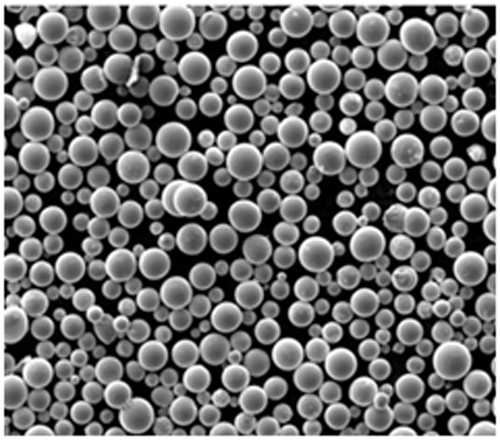
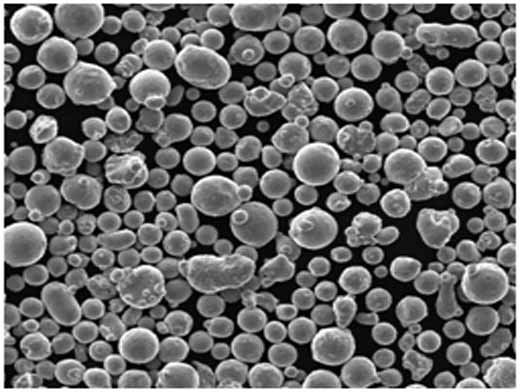


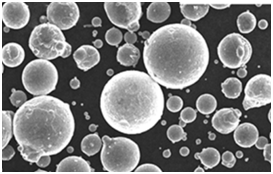
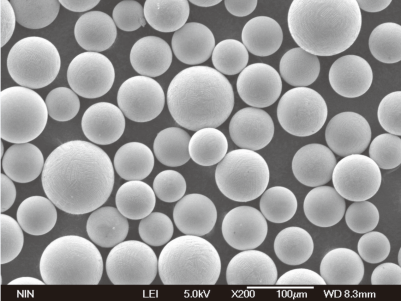
특정 금속 분말 모델
시장에서 무엇을 사용할 수 있는지 더 명확하게 보여주기 위해 특정 응용 분야와 산업을 위해 설계된 구상화 분말의 10가지 특정 모델이 있습니다.
1. Fe 기반 구형 분말
- 구성: 주로 철이며 탄소 및 기타 합금 원소가 미량 함유되어 있습니다.
- 속성: 높은 강도, 우수한 내마모성 및 열적 안정성.
- 애플리케이션: 분말 야금, 자동차 부품, 산업용 공구.
2. AlSi10Mg 구형 분말
- 구성: 알루미늄에 10% 실리콘과 0.4% 마그네슘이 함유되어 있습니다.
- 속성: 경량, 우수한 열 전도성 및 우수한 기계적 특성.
- 애플리케이션: 항공우주, 자동차 및 경량 구조 부품.
3. Ti6Al4V 구형 분말
- 구성: 6% 알루미늄과 4% 바나듐이 합금된 티타늄.
- 속성: 높은 강도 대 중량 비율, 우수한 내식성.
- 애플리케이션: 항공우주, 의료 임플란트, 고성능 엔지니어링 부품.
4. 316L 스테인리스강 구형 분말
- 구성: 철, 크롬, 니켈, 몰리브덴.
- 속성: 내식성, 우수한 기계적 특성, 생체 적합성.
- 애플리케이션: 의료 기기, 식품 가공 장비, 화학 가공.
5. Inconel 718 구형 분말
- 구성: 크롬, 니오븀 및 몰리브덴이 함유된 니켈 기반 초합금.
- 속성: 우수한 고온 강도, 산화 및 내식성.
- 애플리케이션: 항공우주, 가스 터빈, 고온 응용 분야.
6. CuCrZr 구형 분말
- 구성: 크롬과 지르코늄이 합금된 구리 합금.
- 속성: 높은 전기 및 열 전도성, 우수한 기계적 특성.
- 애플리케이션: 전기 부품, 열 관리, 열 교환기.
7. CoCrMo 구형 분말
- 구성: 코발트, 크롬, 몰리브덴.
- 속성: 우수한 내마모성, 생체 적합성, 내식성.
- 애플리케이션: 의료 임플란트, 치과 보철물, 절삭 공구.
8. 마레이징강 구형 분말
- 구성: 코발트, 몰리브덴 및 티타늄이 함유된 철-니켈 합금.
- 속성: 높은 강도, 우수한 인성, 시효 경화 능력.
- 애플리케이션: 항공우주, 공구, 고응력 응용 분야.
9. AlSi12 구형 분말
- 구성: 12% 실리콘이 함유된 알루미늄.
- 속성: 경량, 우수한 내식성, 주조 용이성.
- 애플리케이션: 자동차, 항공우주 및 일반 엔지니어링 부품.
10. 17-4 PH 스테인리스강 구형 분말
- 구성: 철, 크롬, 니켈 및 구리.
- 속성: 높은 강도, 내식성, 우수한 용접성.
- 애플리케이션: 항공우주, 화학 가공, 해양 환경.
이러한 각 분말은 의도된 응용 분야의 요구 사항을 충족하도록 특별히 설계되어 현대 제조에서 구상화 분말의 다재다능함과 적응성을 보여줍니다.
구상화 분말의 장점
구상화 분말을 선택해야 하는 이유는 무엇인가요?
구상화 분말은 불규칙한 분말에 비해 돋보이게 만드는 다양한 이점을 제공합니다. 주요 장점 중 일부를 살펴보겠습니다.
| 이점 | 설명 |
|---|---|
| 향상된 흐름성 | 구형 모양은 3D 프린팅과 같은 공정에서 매우 중요한 우수한 유동 특성을 허용합니다. |
| 더 높은 충전 밀도 | 구형 입자는 더 가깝게 충전되어 최종 부품의 밀도와 기계적 특성을 향상시킵니다. |
| 산화 감소 | 표면적이 작아 산화 가능성이 줄어들어 최종 제품의 순도가 높아지고 품질이 향상됩니다. |
| 향상된 열적 안정성 | 구형 분말은 고온에서 더 안정적이므로 극한 환경에서의 응용 분야에 이상적입니다. |
| 표면 마감 개선 | 매끄러운 구형 입자는 코팅 및 인쇄 공정에서 더 나은 표면 마감을 생성합니다. |
| 일관된 품질 | 균일한 모양과 크기 분포는 서로 다른 배치에서 더 예측 가능하고 반복 가능한 결과를 얻을 수 있습니다. |
이러한 장점으로 인해 구상화 분말은 정밀도, 성능 및 신뢰성이 가장 중요한 산업에서 선호되는 선택입니다.
구상화 분말과 기존 금속 분말 비교
구상화 분말 대 불규칙 분말
응용 분야에 적합한 분말을 선택할 때 구상화 분말과 기존 불규칙 분말의 차이점을 이해하는 것이 중요합니다. 비교는 다음과 같습니다.
| 측면 | 구상화 분말 | 기존 불규칙 분말 |
|---|---|---|
| 모양 | 구형, 매끄러운 | 불규칙하고 다양한 모양 |
| 흐름성 | 우수 | 모양과 크기에 따라 보통에서 불량 |
| 충전 밀도 | 높음 | 불규칙한 모양으로 인해 낮음 |
| 내산화성 | 표면적이 작아짐으로 인해 우수함 | 산화 가능성이 높고 노출된 표면적이 더 큼 |
| 열 안정성 | 일반적으로 더 높음 | 구성에 따라 다름 |
| 표면 마감 품질 | 일관된 입자 모양으로 인해 우수함 | 거친 입자 형태학으로 인해 낮음 |
| 비용 | 일반적으로 추가 가공으로 인해 더 높음 | 낮음, 더 간단한 생산 공정 |
구상화 분말은 더 비싼 경향이 있지만, 주요 분야에서 우수한 성능을 발휘하므로 특히 고정밀 산업에서 추가 비용을 정당화하는 경우가 많습니다.
구상화 분말의 응용 분야
적층 제조(3D 프린팅)
구상화 분말의 가장 두드러진 응용 분야 중 하나는 적층 제조, 특히 금속 3D 프린팅입니다. 이러한 분말의 높은 유동성과 충전 밀도는 재료 층의 정밀한 증착을 가능하게 하며, 이는 상세하고 구조적으로 견고한 부품을 생산하는 데 매우 중요합니다.
- 혜택: 일관된 재료 흐름, 향상된 기계적 특성 및 우수한 표면 마감.
- 산업 분야: 항공우주, 자동차, 의료 기기.
분말 야금
분말 야금에서는 조밀하고 강한 부품을 생산하는 능력이 매우 중요합니다. 구상화 분말은 압축 및 소결 공정을 통해 이러한 목표를 달성하는 데 필요한 특성을 제공합니다.
- 혜택: 더 높은 밀도, 향상된 기계적 특성 및 일관된 품질.
- 산업 분야: 자동차, 산업용 공구, 기계.
용사 코팅
구상화 분말은 또한 구형 모양이 기판에 균일한 분포와 강력한 접착력을 보장하는 열 스프레이 코팅에도 널리 사용됩니다.
- 혜택: 향상된 내마모성, 부식 방지 및 오래 지속되는 코팅.
- 산업 분야: 항공우주, 산업 기계, 해양.
금속 사출 성형(MIM)
금속 사출 성형에서 원료의 유동성은 고정밀도로 복잡한 부품을 생산하는 데 매우 중요합니다. 구상화 분말은 이를 달성하는 데 필요한 특성을 제공합니다.
- 혜택: 더 나은 유동성, 향상된 부품 밀도 및 우수한 기계적 특성.
- 산업 분야: 의료 기기, 소비자 전자 제품, 자동차.
표면 처리
구상화 분말은 부품의 내마모성, 경도 및 내식성을 향상시키기 위해 표면 처리 공정에 사용됩니다. 구형 모양은 균일한 코팅을 보장하고 처리된 표면의 전반적인 성능을 향상시킵니다.
- 혜택: 향상된 내구성, 연장된 부품 수명 및 향상된 성능.
- 산업 분야: 산업 기계, 자동차, 항공우주.
구상화 분말의 사양 및 표준
주요 사양 및 표준
응용 분야에 구상화 분말을 선택할 때는 적용되는 사양 및 표준을 고려하는 것이 중요합니다. 주요 측면을 요약한 표는 다음과 같습니다.
| 사양 | 설명 |
|---|---|
| 입자 크기 분포 | 일반적으로 |
| 순도 | 최종 제품의 불순물과 결함을 최소화하기 위해 종종 99% 이상인 고순도 수준. |
| 유량 | 주어진 부피에 대해 초 단위로 측정되며, 분말의 부드러운 흐름 능력을 나타냅니다. |
| 겉보기 밀도 | 분말이 얼마나 조밀하게 쌓이는지를 나타내는 척도로, 일반적으로 구형화된 분말의 경우 더 높습니다. |
| 구형성 | 입자의 구형도를 측정하는 척도로, 일반적으로 고품질 분말의 경우 1에 가깝습니다. |
| 표준 | 일반적인 표준에는 입자 크기, 조성 및 품질에 대한 요구 사항을 명시하는 ASTM, ISO 및 DIN이 포함됩니다. |
이러한 사양을 준수하면 선택한 분말이 특정 응용 분야에 필요한 성능 기준을 충족하는지 확인할 수 있습니다.
공급업체 및 가격
주요 공급업체 및 가격 정보
구형화 분말에 적합한 공급업체를 찾는 것은 일관된 품질과 안정적인 공급을 보장하는 데 매우 중요합니다. 다음은 주요 공급업체 및 가격 정보를 간략하게 살펴봅니다.
| 공급업체 | 위치 | 제품 범위 | ID: 가격(근사치) | 주요 고객 |
|---|---|---|---|---|
| 샌드빅 적층 제조 | 스웨덴 | 다양한 금속 분말 | $50 – $150/kg | 항공우주, 의료, 산업 |
| 호가나스 AB | 스웨덴 | 고품질 금속 분말 | $40 – $120/kg | 자동차, 산업, 전자 |
| 카펜터 기술 | 미국 | 특수 합금 분말 | $60 – $180/kg | 항공우주, 에너지, 산업 |
| AP&C(GE 애디티브) | 캐나다 | 티타늄 및 니켈 기반 분말 | $70 – $200/kg | 항공우주, 의료, 자동차 |
| LPW Technology (Carpenter Technology) | UK | AM 전용 분말 | $55 – $160/kg | 항공우주, 의료, 산업 |
가격은 분말 조성, 입자 크기 분포 및 주문량과 같은 요인에 따라 달라질 수 있습니다. 샘플을 요청하고 철저한 테스트를 수행하여 분말이 특정 요구 사항을 충족하는지 확인하는 것이 좋습니다.
구형화 분말의 장단점
장점과 단점
구형화 분말은 많은 장점을 제공하지만 단점도 있습니다. 다음은 장단점에 대한 균형 잡힌 시각입니다.
| 장점 | 단점 |
|---|---|
| 향상된 흐름성 | 더 높은 비용: 구형화 공정은 전체 비용을 증가시킵니다. |
| 더 높은 충전 밀도 | 복잡한 제조: 고급 장비와 기술이 필요합니다. |
| 산화 감소 | 제한된 가용성: 모든 금속이 쉽게 구형화되는 것은 아닙니다. |
| 향상된 표면 마감 | 오염 가능성: 오염을 방지하기 위해 취급을 주의해서 관리해야 합니다. |
| 일관된 품질 | 더 긴 리드 타임: 맞춤형 분말은 생산 시간이 더 오래 걸릴 수 있습니다. |
이러한 장단점을 이해하면 프로젝트에 구형화 분말을 선택할 때 정보에 입각한 결정을 내리는 데 도움이 될 수 있습니다.
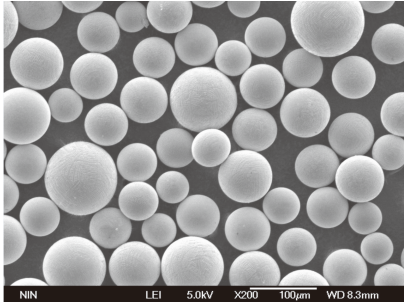
자주 묻는 질문
| 질문 | 답변 |
|---|---|
| 구형화 분말이란 무엇입니까? | 구형화 분말은 유동성 및 충전 밀도를 개선하기 위해 구형 모양을 얻도록 처리된 금속 분말의 한 유형입니다. |
| 구형 분말이 더 나은 이유는 무엇입니까? | 구형 분말은 불규칙한 분말에 비해 유동성이 더 좋고, 충전 밀도가 높으며, 산화가 감소하고, 표면 마감이 개선됩니다. |
| 어떤 산업에서 구형화 분말을 사용합니까? | 항공우주, 자동차, 의료 및 산업 제조와 같은 산업에서는 다양한 응용 분야에 구형화 분말을 사용합니다. |
| 구형화 분말은 어떻게 만들어집니까? | 구형화 분말은 일반적으로 입자를 구형으로 둥글게 만드는 분무 또는 열처리 공정을 통해 만들어집니다. |
| 고려해야 할 주요 사양은 무엇입니까? | 주요 사양에는 입자 크기 분포, 순도, 유량, 겉보기 밀도 및 구형도가 포함됩니다. |
| 구형화 분말이 더 비쌉니까? | 예, 구형화 분말은 구형 모양을 얻기 위해 추가적인 처리가 필요하기 때문에 일반적으로 더 비쌉니다. |

